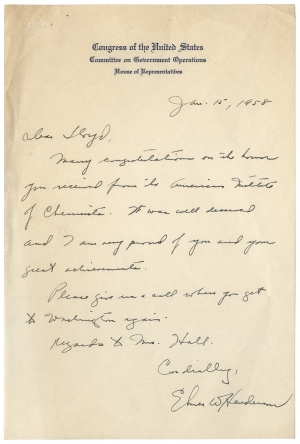|
Elmer W. Henderson – Who Defeated Railroad Dining Car Segregation – Congratulates African American Inventor for American Institute of Chemists Award |
Click to enlarge:

Congressional attorney Elmer W. Henderson, a hero of the early civil rights movement, congratulates African American chemist Lloyd A. Hall for a recent professional honor. In 1955, Hall also became the first African American elected to the National Board of Directors of the American Institute of Chemists (AIC). The following year, the AIC awarded Hall the Honor Scroll Award. On special occasions, the AIC invites a prominent chemist or chemical engineer to lecture to the Members and Fellows of the AIC on a topic of professional interest. In September 1957, Hall delivered a lecture on “The Chemist and the AIC,” likely the occasion for this congratulatory letter from Henderson a few months later.
ELMER W. HENDERSON.
Autograph Letter Signed, to Lloyd Augustus Hall, January 15, 1958, Washington, DC. On “Congress of the United States / Committee on Government Operations / House of Representatives” letterhead. 1 p., 6 x 9 in.
Inventory #26468
Price: $450
Elmer W. Henderson congratulates Lloyd Hall “on the honor you received from the American Institute of Chemists. It was well deserved and I am very proud of you and your great achievements.”
Sixteen years earlier, Henderson became a hero of the early Civil Rights movement. In May 1942, Henderson was denied dining car service during a first-class trip from Washington, D.C. to Birmingham, Alabama, aboard the Southern Railway. He was a federal government employee at the time, the Midwest regional director of President Roosevelt’s Committee on Fair Employment Practices during wartime. Henderson filed a complaint alleging that railroad dining car segregation violated the Interstate Commerce Act. In their 8-0 ruling in Henderson v. United States, 339 U.S. 816 (1950), the U.S. Supreme Court found that segregated dining cars violated the Interstate Commerce Act and ended the practice of racial segregation in American railway dining cars.
Elmer W. Henderson (1913–2001) was born in Baltimore, graduated from Morgan State University, and received a master’s degree from the University of Chicago and a law degree from Georgetown University. He served as an adjunct professor of political science at Howard University, and he directed the American Council on Human Rights between 1948 and 1955. From 1955 to 1982, he served as legal counsel and then as general counsel to the Government Operations Committee, the investigative body of the House of Representatives. He retired in 1982.
Lloyd Augustus Hall (1894–1971) was born in Illinois, the grandson of a woman who came to Illinois on the “Underground Railroad.” Hall graduated with a degree in pharmaceutical chemistry from Northwestern University and also studied at the University of Chicago. He served with the U.S. Ordnance Department during World War I. After the war, he became the chief chemist for Boyer Chemical Laboratory. In 1925, he took a position at Griffith Laboratories, where he remained for thirty-four years. Hall invented several ways to preserve food, ultimately receiving 59 U.S. patents and additional patents in Canada and Great Britain. Most preservation methods used salts, but it was difficult to keep foods from spoiling without making them taste bitter. In 1932, Hall combined salt with sodium nitrate & nitrite to suppress the nitrogen that spoiled food. His method of curing meats is still used. He also developed new uses of antioxidants to prevent food from spoiling. Hall found that some spices exposed food to bacteria that sped up the process of spoiling, so he developed a method to sterilize the spices. The food, drug, and cosmetic industries later adopted Hall’s method of sterilizing spices in a vacuum chamber.
Condition: Expected folds and a few wrinkles; scattered staple holes and soiling in the upper left corner.